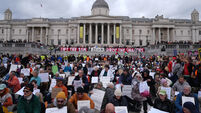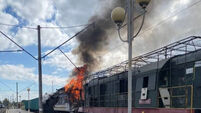Airstrikes intensify as surrender deadline slips by
Tribal commanders fighting al-Qaida troops in Afghanistan’s White Mountains said today they had abandoned another plan for bin Laden’s men to disarm and surrender.
US airstrikes intensified dramatically as tribal fighters launched a new ground assault against the trapped al-Qaida forces, following claims key terrorist leaders have fled the besieged mountain bases for neighbouring Pakistan.
The whereabouts of bin Laden remain unknown.
Tribal officers said their forces were determined to crush the enemy, most of them Arabs and other foreign Muslim fighters.
‘‘The al-Qaida forces are about to be finished,’’ said Hamid, an alliance commander, who gave only one name. ‘‘They don’t have any more food or ammunition.’’
Hamid said today’s assault was ordered after it became clear senior al-Qaida chiefs had fled the Tora Bora area, abandoning their rank-and-file troops.
He said the fleeing leaders might be trying to cross the Pakistan border, just a few miles south across the White Mountain range.
Pakistan has said it has reinforced the border to prevent al-Qaida incursions. It was also unclear why the Afghans thought major al-Qaida figures had taken part in the defence of Tora Bora.
Several figures of the Eastern Alliance had offered vague, second-hand accounts of seeing bin Laden, but US Deputy Defence Secretary Paul Wolfowitz questioned their accuracy.
However, the £17m US bounty on bin Laden was a powerful incentive for the Afghan militias to lay siege to Tora Bora.
Bombing was relentless last night and into this morning.
High-flying B-52s circled above the combat zone in the foothills of Afghanistan’s eastern White Mountains. Fighter aircraft roared across the Tora Bora and Milawa valleys.
After one jet dropped its payload of 1,000 lb bombs on an al-Qaida post, an Afghan soldier on the ground could be heard cheering over the alliance’s radio network.
‘‘Thank you. Thank you very much,’’ he said in English after the target was reduced to a smoking heap of rubble.
Pentagon officials said the bombs included satellite-guided weapons that home in on their targets and the biggest conventional bomb in the US arsenal, the 15,000 lb ‘‘daisy cutter,’’ which obliterates everything within a few hundred yards when it explodes.
At least one, and perhaps as many as three, ‘‘daisy cutters’’ were dropped before dawn on a mountainside canyon where many al-Qaida men have been hemmed in since they were flushed out of their cave shelters during combat on Monday.
A reporter, who saw one blast, said a huge, bright magenta fire ball hung in the air and produced a false dawn effect as it lit up the sky at around 3 am.
Casualty figures from the latest bombardment were not known.
US special forces deployed by helicopters helped coordinate the air strikes.
American AC-130 gunships, slow-moving armoured aircraft armed with Gatling guns, strafed al-Qaida positions.
US officials said it was not clear whether some enemy personnel were still sheltering in the hundreds of caves and tunnels that riddle the area.
Today’s aerial assault came after an initial surrender deal between the US-backed alliance and al-Qaida troops fell through yesterday.
After that deal failed, tribal commanders set a new deadline of midday today for trapped al-Qaida fighters to give up on condition their leaders be handed over as well.
The alliance said that some of those leaders are on a list of 22 ‘‘most wanted terrorists’’ made public by Washington after the September 11 terror attacks in the United States.





